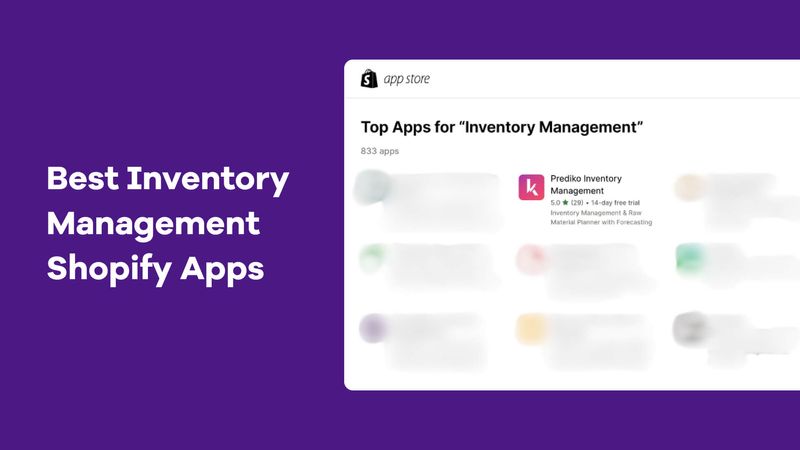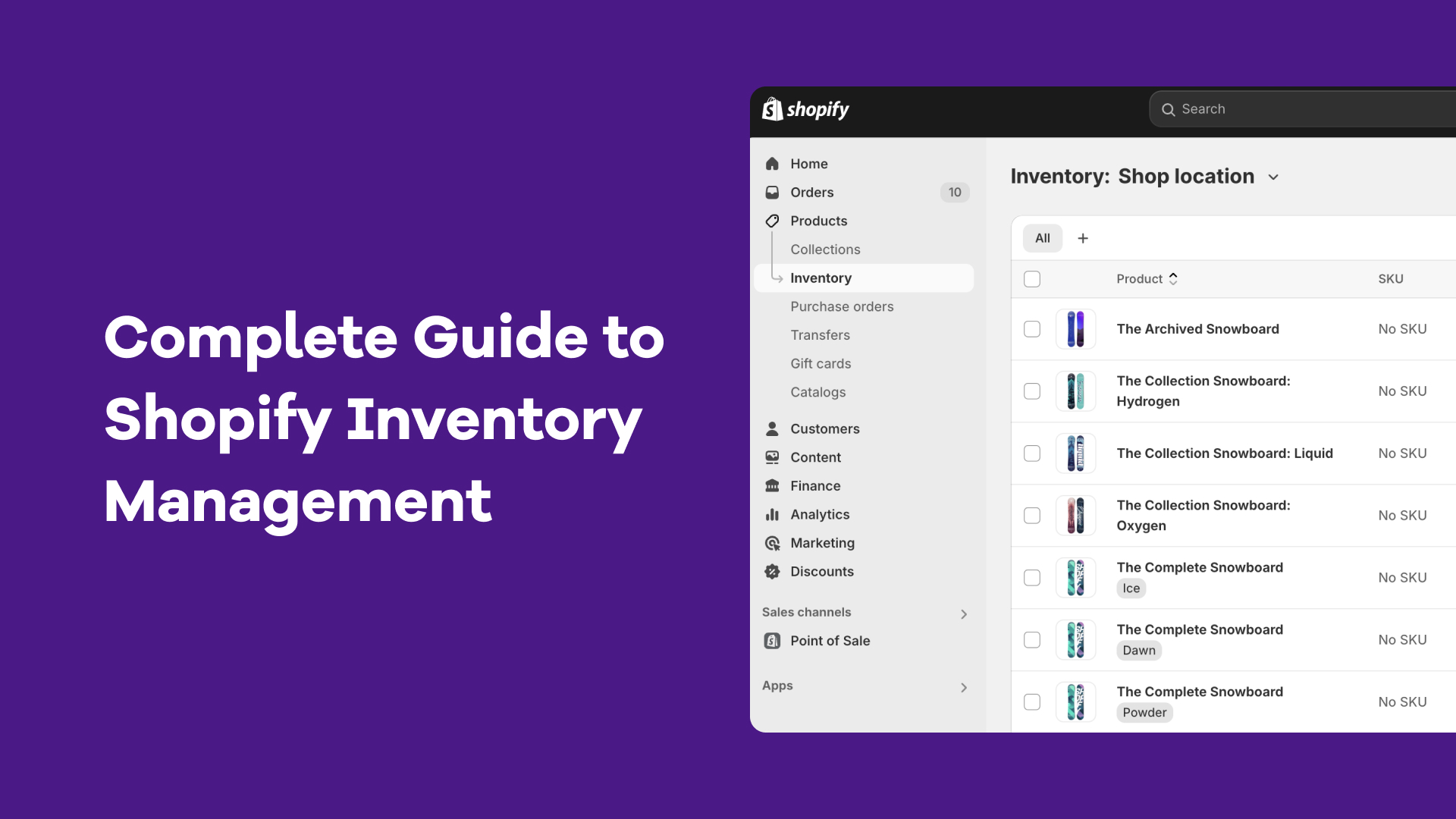82% of small businesses fail because of poor cash flow. One of the biggest reasons? Inventory that doesn’t move.
When products sit on shelves too long, your cash gets stuck. You can’t reinvest, restock, or stay flexible.
D2C merchants experience this all the time. Low inventory velocity makes cash flow tighter than it needs to be.
That’s why maintaining a healthy inventory velocity ratio matters.
We spoke with several retail brand owners to put this guide together. Below, you’ll learn what inventory velocity is, why it matters, and how to calculate it and improve it.
What is Inventory Velocity?
Inventory velocity measures how quickly your products sell and are replaced over a given period. In simpler terms, it tells how fast your inventory turns into revenue, helping you understand which SKUs need reordering.
A higher inventory velocity means products are selling quickly and being restocked regularly, while a lower velocity suggests slow-moving inventory that may be tying up capital and taking up storage space.
What inventory velocity is not
Inventory velocity is not just about selling fast; it’s about selling efficiently.
High velocity doesn’t necessarily mean high profits. If you’re selling quickly but constantly restocking the wrong items or relying on heavy discounts to move products, it may indicate deeper inefficiencies.
It’s also not the same as turnover rate in accounting, which looks at the broader cost of goods sold. Inventory velocity is a more focused, operational view on how effectively you’re moving the right products at the right pace.
Curious about how to calculate inventory turnover rate? Read the full guide here.
Why Inventory Velocity matters for eCommerce businesses
Before we learn how inventory velocity can be calculated, we need to understand why it matters.
1. Better cash flow
The faster your products move, the faster your cash flows.
Inventory velocity directly impacts how quickly cash tied up in inventory returns to your business, and in e-commerce, that liquidity can be the difference between scaling up or stalling out.
“By improving our inventory velocity, we were able to significantly improve cash flow. We did this by focusing on the most in-demand items and rotating stock quickly. This allowed us to keep cash circulating in the business, freeing up resources to reinvest in growth without worrying about tying up money in unused stock.” — Daniel Vasilevski, Owner, Pro Electrical
Just like Daniel, if your stock is sitting too long on the shelves, you’re essentially freezing money that could be put to better use, whether that’s restocking faster-moving items, investing in marketing, or improving customer experience.
Higher velocity unlocks that capital and keeps your business financially agile.
2. Reduced inventory carrying costs
Holding inventory takes up shelf space and also comes with a financial burden. Storage fees, insurance, depreciation, and the risk of damage or obsolescence all add up. And the longer products sit unsold, the more they eat into your profits.
High carrying costs can slow down your ability to adapt and reinvest. Capital that’s tied up in slow-moving stock can’t be used to buy fast-selling products, launch campaigns, or respond to changing market trends.
What looks like a full warehouse might actually be a sign of frozen potential.
This rings especially true in environments with high storage costs, as highlighted by Philip Carls, former pricing lead at Walmart and Amazon Europe, “For some retailers, carrying costs are not so great but for others, it’s a significant cost and, in high inflationary environments, inventory velocity is particularly critical, as retailers have high holding costs.
Seasonality is key, too. You don’t want to be sitting on 100,000 BBQ grills over the winter. Then there’s not only the holding cost to consider but also the opportunity cost of not carrying items which could sell in the first place.”
3. Adapting to demand changes
When demand shifts suddenly, whether it’s due to seasonality, trends, or external factors, your Shopify store needs the flexibility to act fast.
High inventory velocity gives you that flexibility. When inventory is moving quickly, you’re not stuck with last month’s stock. You’ve got the cash and the shelf space to restock high-demand products, shift direction, or test new SKUs.
But that kind of responsiveness only works when it’s paired with strong forecasting. Without visibility into what’s about to come, you won’t know what to act on, or when.
Daniel Vasilevski, owner of Pro Electrical, shared, “With more accurate tracking and forecasting, we were able to adjust stock levels on the fly, ensuring we had what we needed without overstocking or running out.”
How to Calculate Inventory Velocity
Sales velocity of inventory is typically calculated using one of two formulas. Both help you understand how efficiently you’re moving products, either by value or by unit.
Inventory Velocity Formula 1: Based on the cost of goods sold (COGS)
Inventory Velocity = Cost of Goods Sold (COGS) / Average Inventory
- COGS is the total cost of products sold during a specific period (usually annually).
- Average Inventory is the average value of inventory held during that period, calculated using (Beginning Inventory + Ending Inventory) / 2
Let’s say your store sold $120,000 worth of products last year (COGS), and you carried an average inventory of $30,000. Then, Inventory Velocity = $120,000 / $30,000 = 4.
Inventory Velocity Formula 2: Based on units sold
Inventory Velocity = Total Units Sold / Average Units in Stock
- Use this if you track inventory by units instead of value
- Units Sold is your total sales volume over a period
- Average Units in Stock is the average quantity of items on hand calculated using (Beginning Inventory + Ending Inventory) / 2
Now, let’s say you sold 6,000 units over the year, and your average inventory was 1,500 units. Then, Inventory Velocity = 6,000 units / 1,500 units = 4.
Both formulas give the same result in this inventory velocity example, just from different angles, one in dollars, one in units. Choose the one that aligns best with how you track performance in your business.
What’s a “good” inventory velocity?
It depends on your business. For fast-moving categories like groceries or personal care, a velocity of 8–12 might be normal. For slower-moving items like furniture or seasonal products, even 2–3 can be healthy.
The key is this: a “good” velocity is one that keeps your cash flowing without risking stock outs or overstocks, and that will vary based on your seasonality, lead times, and product life cycles.
Effective Strategies to Improve Inventory Velocity
Below are some proven strategies to increase inventory movement and free up working capital.
1. Implement smart demand forecasting
Poor forecasting puts you in a constant tug-of-war between stock surplus and shortage. This is why you need accurate demand forecasting.
To do just that, you need to factor in past sales, seasonal patterns, and upcoming marketing plans. When done right, it keeps your inventory balanced, responsive, and profitable.
Prediko pulls 12 months of sales data from your store and uses AI to forecast demand, factoring in seasonality and growth patterns.
It gives you reorder recommendations based on real trends, not rough guesses, so you can plan with confidence instead of reacting.
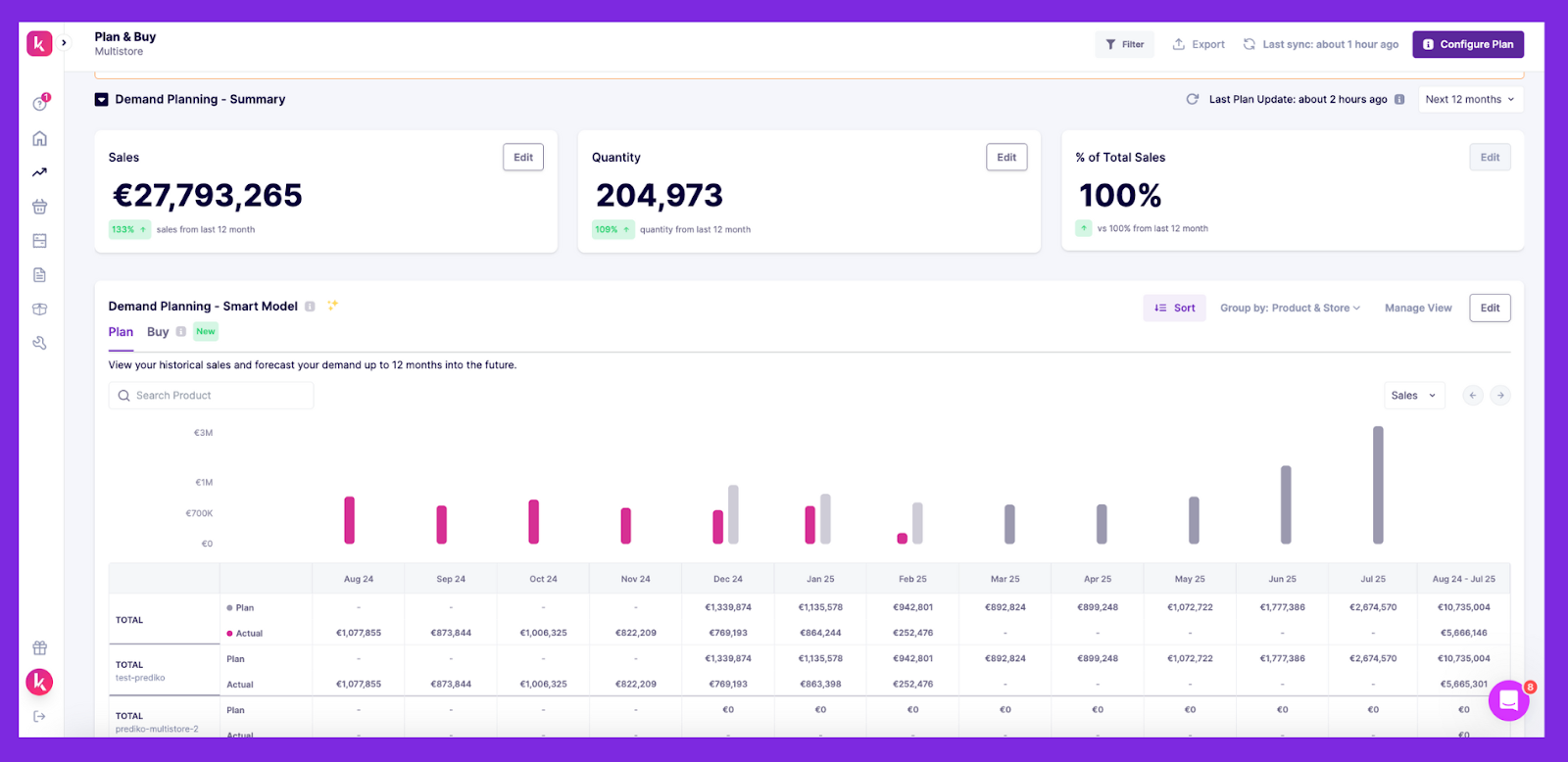
2. Go lean with your inventory
Lean inventory means carrying just enough stock to meet demand, no more, no less. It doesn’t mean understocking or risking delays. It means getting efficient.
You free up cash, reduce waste, and simplify operations by trimming the excess that doesn’t move.
Here’s what you can do to implement lean inventory
- Shorten your purchase cycles. Instead of ordering large batches every few months, order smaller quantities more frequently. This keeps your stock fresher and more responsive to real demand.
- Know your supplier lead times. When you know exactly how long it takes to restock, you can order just in time, not just in case.
- Use real-time inventory tracking. Don’t rely on gut feel or manual stock checks. A good inventory software like Prediko helps you see exactly what’s moving and when to reorder in real-time.
- Apply the ABC method. Run an ABC analysis on your products. A-items are your fastest movers and should be prioritized for restocking. B- and C-items can be ordered more cautiously.
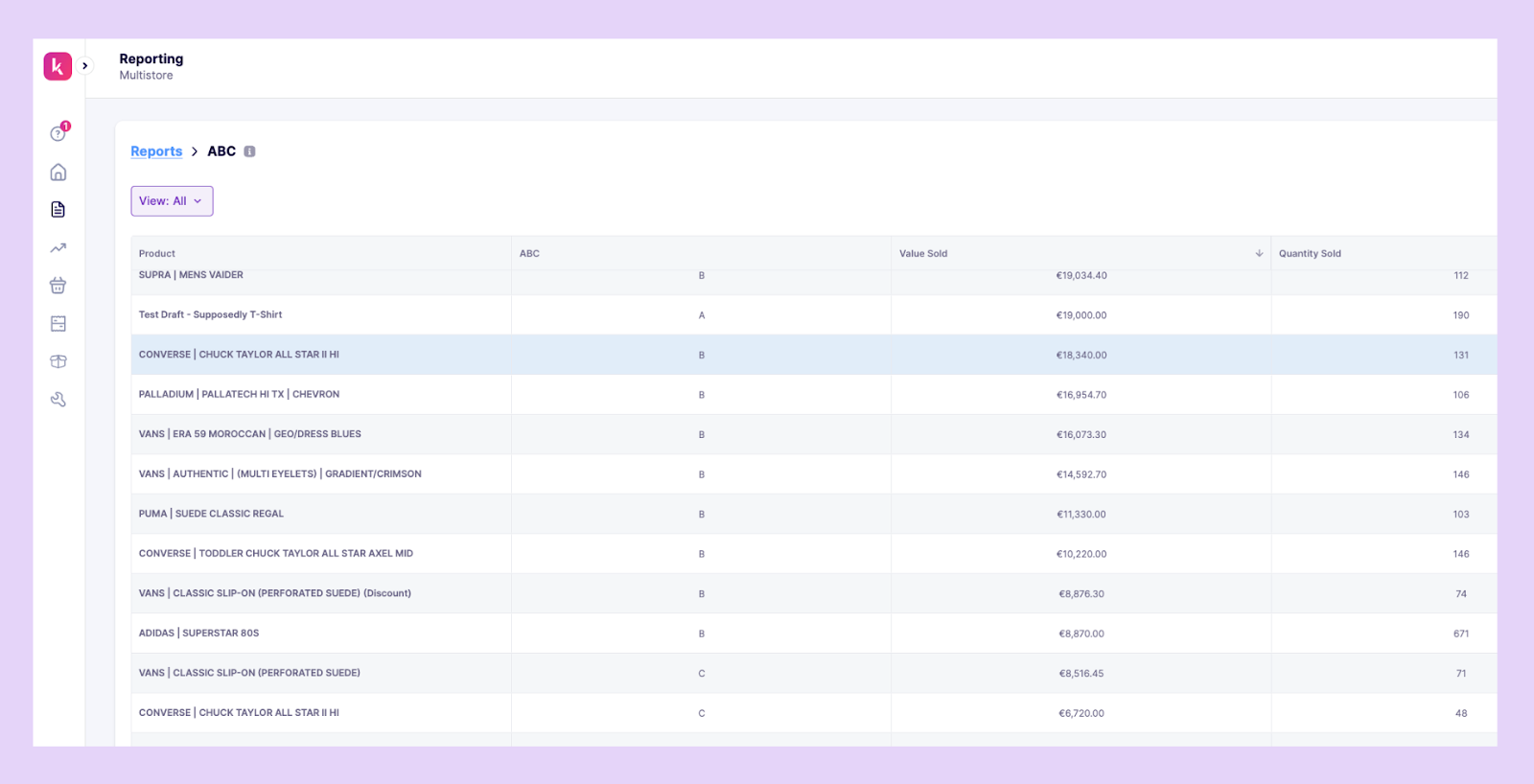
If you want to learn more about doing a Shopify ABC analysis, here’s the full guide.
3. Use pricing and product swaps to increase inventory velocity
If your inventory isn’t moving, it’s not just sitting on shelves; it’s blocking better products from taking their place.
That’s why one of the most effective ways to improve inventory velocity is to actively manage what stays and what goes.
Start by identifying slow-moving SKUs, marking them down, and replacing them with products that have higher demand and a faster sales cycle.
For example, Lou Haverty, CEO of Tank Retailer, discounts products that aren’t selling quickly and replaces them with items customers want more. This improves cash flow and frees up money to reinvest in better products.
He shares, “You also need to take the additional step of marking down prices on slow-moving inventory and replacing that slow-moving inventory with higher demand products.”
The strategy is simple. Discount what’s dragging you down, double down on what’s moving. Over time, your catalog evolves to include more high-velocity products, and your inventory becomes easier (and cheaper) to manage.
4. Reorder using data
Poorly set reorder points can quietly hurt your inventory performance.
Without real-time data, you’re either setting reorder points too high or too low, leaving you overstocked or at risk of stockouts without knowing it.
A reorder system must look at three things: how quickly each product sells, how long your suppliers take to deliver, and how much buffer stock you need.
When you combine these inputs, you get a reorder point. Use this formula to calculate it manually.
Reorder Point = (Daily Units Sold × Lead Time in Days) + Safety Stock
Now, calculating reorder points is a manual process that needs constant updating.
Prediko automates this, adjusting reorder points in real time based on demand and lead times. It then sends reorder alerts so you can act quickly.
Here’s a step-by-step bonus guide on automating your restock workflows.
How Prediko Helps Improve Inventory Velocity
An inventory management software like Prediko can make a big difference in improving your inventory velocity. How?
Inventory velocity improves when your demand forecasting is accurate, your reordering is automated, and your workflows are built for how you actually sell. Prediko does all of that, from one dashboard.
1. Automation that speeds up stock movement

Prediko removes delays in your inventory workflows with AI-powered automation. This reduces manual reordering tasks and keeps your operations moving.
- Automated PO creation: It generates purchase orders based on real-time inventory levels and demand forecasts. Brands like Sync Protein, who use Prediko, report saving hours each week compared to manual spreadsheet workflows.
- Smart alerts: Automatic reminders for both overstocks and stockouts based on sales velocity, safety stock, and lead time.
- BOM & raw material tracking: If you manage production, Prediko can sync raw materials and finished goods, helping you restock both in line with demand.
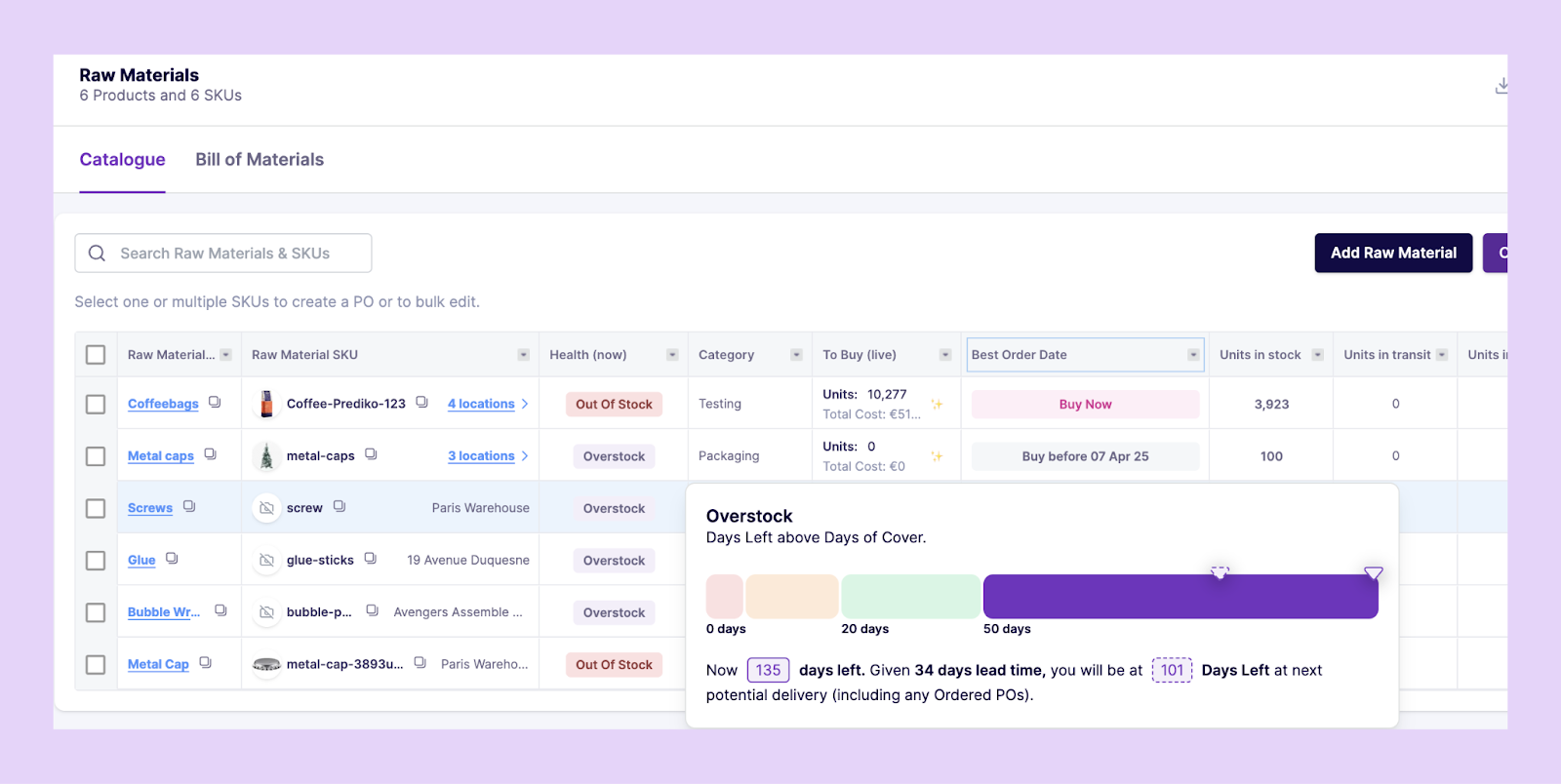
This kind of automation eliminates bottlenecks in reordering and speeds up decision-making across the supply chain.
2. Analytics that prioritize high-velocity products
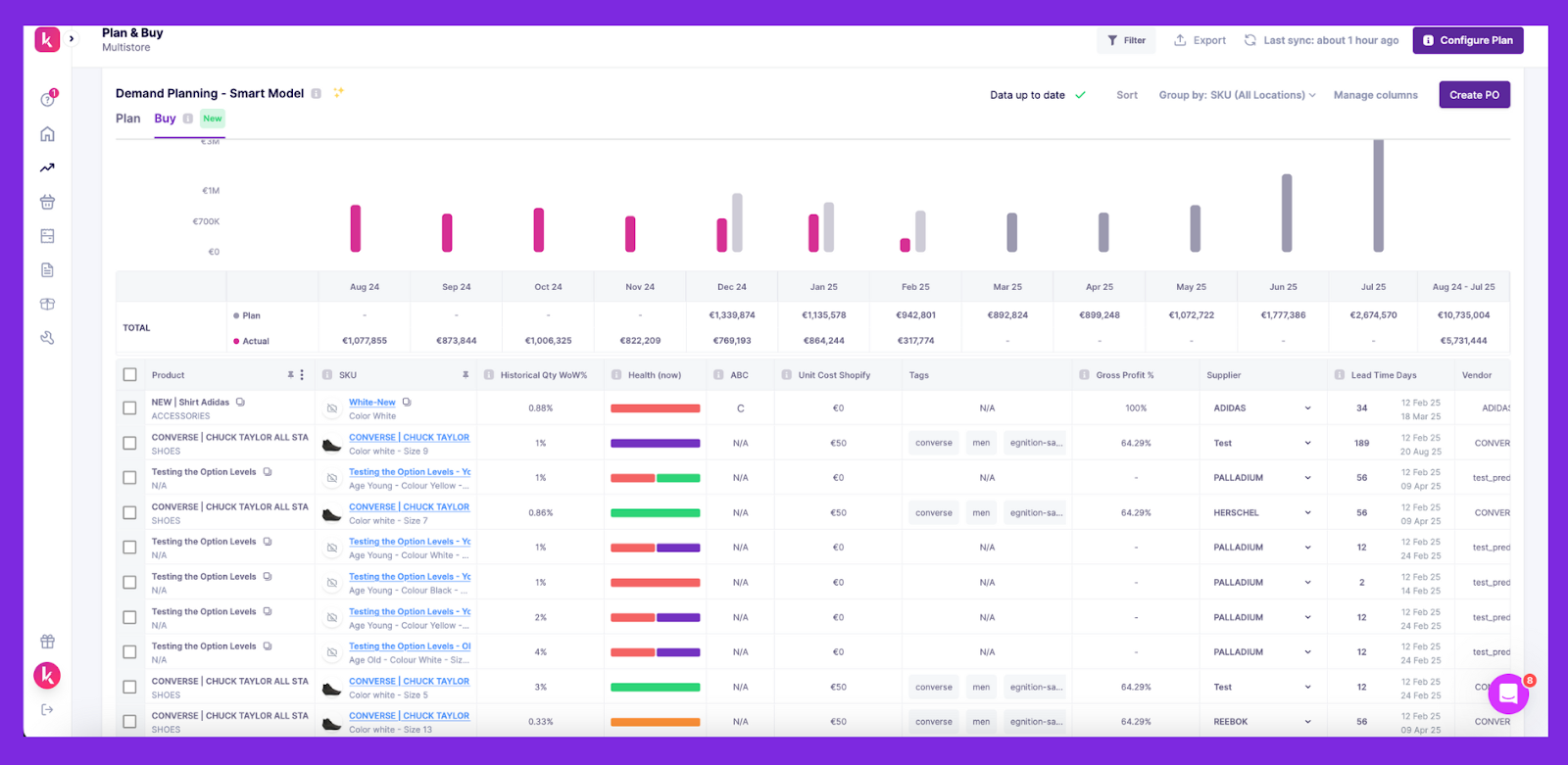
One of the key ways to improve inventory velocity is by knowing what sells fast and doubling down on it. Prediko’s analytics dashboard gives you the clarity to do just that.
- AI-powered demand & supply planning: It predicts sales based on seasonality, market trends, and your inputs. It tells you what and how much to order exactly when it’s needed.
- ABC analysis & sales metrics: Prediko shows you which SKUs are selling and which ones are dragging performance. This helps you shift capital toward high-performing inventory.
- Custom reports: Use 100+ filters to build your reports or choose from presets like sell-through, COGS, and stockout risk. All reports can be scheduled for automatic delivery to your inbox.

When you’re making decisions with this kind of insight, you’re more likely to stock what moves, and avoid what doesn’t.
3. Built for Shopify
Prediko doesn’t just integrate with Shopify, it’s built around it. That means zero setup hassle, real-time sync, and native workflows that fit how you already sell.
For growing brands, having purpose-built inventory management for Shopify ensures that velocity improvements translate directly into operational efficiency — from reorders to restocks.
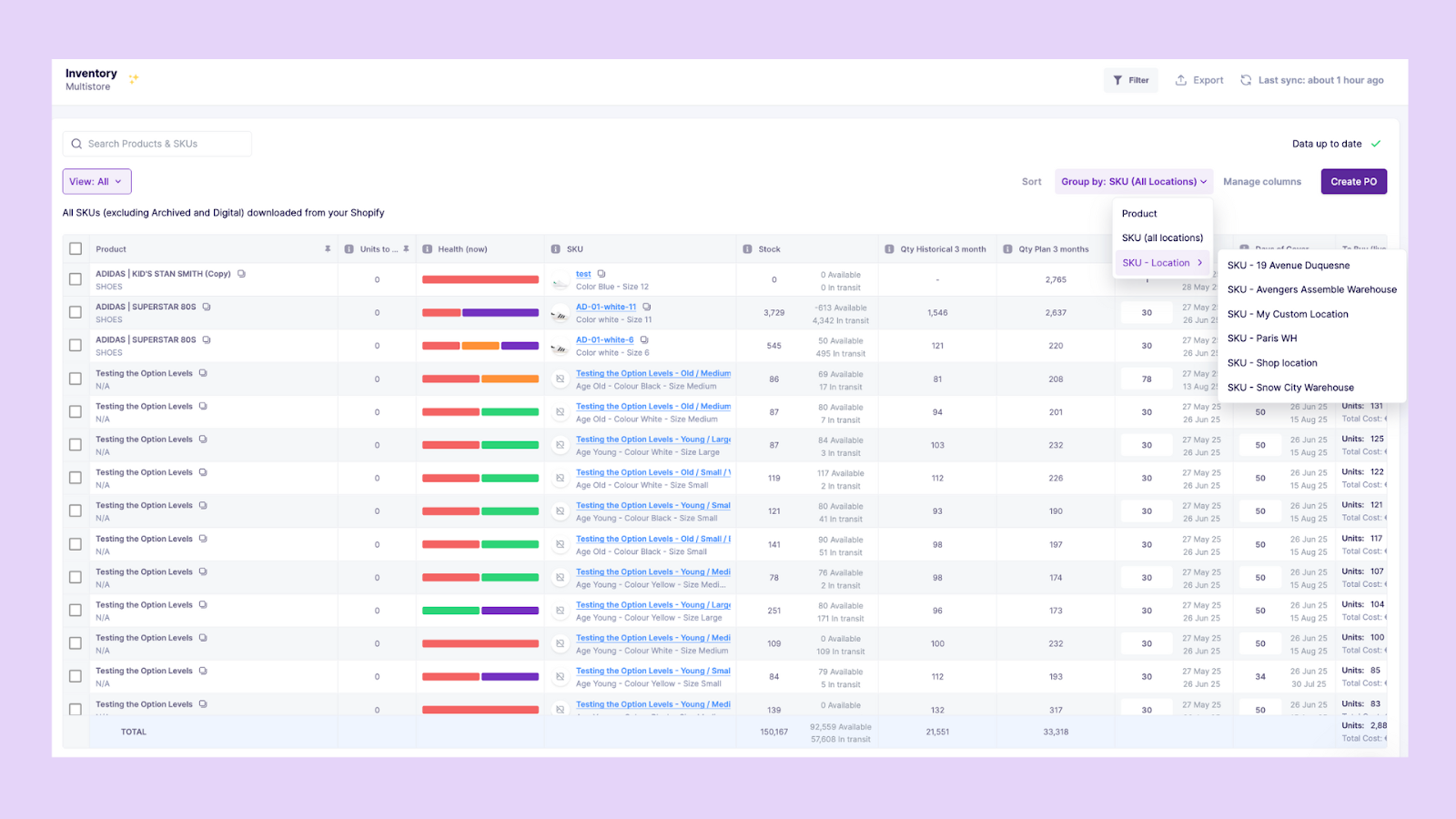
- Live inventory updates: Stock levels update in real-time after every order or restock, keeping reorder triggers and inventory levels accurate.
- Multi-location visibility: You can manage warehouses and stores from one dashboard.
- One-click setup: No lengthy onboarding. And it works with over 60+ apps (WMS, 3PL providers, eCommerce platforms) for a fully connected backend.
Take the First Step Towards Improving Inventory Velocity
We’ve covered why inventory velocity matters, what a healthy number looks like, and how improving it starts with better planning, smarter purchasing, and more responsive stock management.
Prediko helps you execute just this: automating the forecasting, reporting, and reordering process so you can move inventory faster and smarter.
Start your 14-day free trial and take the first step with Prediko.



.avif)



